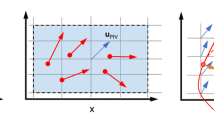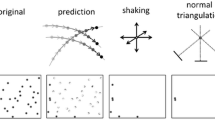Abstract
To date, Tomo-PIV has involved the use of the multiplicative algebraic reconstruction technique (MART), where the intensity of each 3D voxel is iteratively corrected to satisfy one recorded projection, or pixel intensity, at a time. This results in reconstruction times of multiple hours for each velocity field and requires considerable computer memory in order to store the associated weighting coefficients and intensity values for each point in the volume. In this paper, a rapid and less memory intensive reconstruction algorithm is presented based on a multiplicative line-of-sight (MLOS) estimation that determines possible particle locations in the volume, followed by simultaneous iterative correction. Reconstructions of simulated images are presented for two simultaneous algorithms (SART and SMART) as well as the now standard MART algorithm, which indicate that the same accuracy as MART can be achieved 5.5 times faster or 77 times faster with 15 times less memory if the processing and storage of the weighting matrix is considered. Application of MLOS-SMART and MART to a turbulent boundary layer at Re θ = 2200 using a 4 camera Tomo-PIV system with a volume of 1,000 × 1,000 × 160 voxels is discussed. Results indicate improvements in reconstruction speed of 15 times that of MART with precalculated weighting matrix, or 65 times if calculation of the weighting matrix is considered. Furthermore the memory needed to store a large weighting matrix and volume intensity is reduced by almost 40 times in this case.















Similar content being viewed by others
References
Andersen AH, Kak AC (1984) Simultaneous algebraic reconstruction technique (sart): a superior implementation of the art algorithm. Ultras Imaging 6:81–94
Atkinson CH, Soria J (2007a) Algebraic reconstruction techniques for tomographic particle image velocimetry. In: Proceedings of 16th Australasian fluid mechanics conference, Gold Coast
Atkinson CH, Soria J (2007b) Multi-camera digital holographic piv: tomographic dhpiv. In: Proceedings of 16th Australasian fluid mechanics conference, Gold Coast
Elsinga GE, Scarano F, Wieneke B, van Oudheusden BW (2006) Tomographic particle image velocimetry. Exp Fluids 41:933–947
Elsinga GE, Adrian RJ, van Oudheusden BW, Scarano F (2007) Tomographic-piv investigation of a high reynolds number turbulent boundary layer. In: Proceedings of 7th international symposium on particle image velocimetry, Roma
Frigo M, Johnson SG (2005) The design and implementation of fftw3. Proc IEEE 93(2):216–231
Gordon R, Bender R, Herman GT (1970) Algebraic reconstruction techniques (art) for three-dimensional electron microscopy and x-ray photography. J Theor Biol 29:471
Hain R, Kähler CJ, Michaelis D (2008) Tomographic and time resolved piv measurements on a finite cylinder mounted on a flat plate. Exp Fluids 45:715–724
Herman GT, Lent A (1976) Iterative reconstruction algorithms. Comput Biol Med 6:273–294
Herpin S, Wong C, Stanislas M, Soria J (2008) Stereoscopic piv measurements of a turbulent boundary layer with a large spatial dynamic range. Exp Fluids 45:745–763
Lamarche F, Leroy C (1990) Evaluation of the volume of intersection of a sphere with a cylinder by elliptic integrals. Comput Phys Commun 59:359–369
Michael YC, Yang KT (1991) Recent developments in axial tomography for heat transfer and fluid flow studies. Exp Therm Fluid Sci 4:637–647
Mishra D, Muralidhar K, Munshi P (1999) A robust mart algorithm for tomographic applications. Numer Heat Transf Part B 35:485–506
Mueller K, Yagel R (1999) On the use of graphics hardware to accelerate algebraic reconstruction methods. In: SPIE conference on physics of medical imaging, San Diego
Natterer F (1986) The mathematics of computerized tomography. Wiley, Chichester
Press WH, Teukolsky SA, Vetterling WT, Flannery BP (1988) Numerical recipes in C : the art of scientific computing, 2nd edn. Cambridge University Press, Cambridge
Scarano F, Elsinga GE, Bocci E, van Oudheusden BW (2006) Investigation of 3-d coherent structures in the turbulent cylinder wake using tomo-piv. In: 13th international symposium on applications of laser techniques to fluid mechanics, Lisbon
Schröder A, Geisler R, Michaelis D (2007) Flow structures in a tripped turbulent boundary layer flow—an investigation using time-resolved tomographic piv. In: Proceedings of 7th international symposium on particle image velocimetry, Roma
Schröder A, Geisler R, Staack K, Wieneke B, Elsinga GE, Scarano F, Henning A (2008) Lagrangian and eulerian views into a turbulent boundary layer flow using time-resolved tomographic piv. In: 14th international symposium on applications of laser techniques to fluid mechanics, Lisbon
Soloff SM, Adrian RJ, Liu ZC (1997) Distortion compensation for generalized stereoscopic particle image velocimetry. Meas Sci Technol 8:144–1454
Soria J (1996) An investigation of the near wake of a circular cylinder using a video-based digital cross-correlation particle image velocimetry technique. Exp Therm Fluid Sci 12:221–233
Soria J, Atkinson C (2007) Multi-camera digital holographic imaging piv versus tomographic imaging piv—comparison and contrast of these two 3c-3d piv techniques. In: Proceedings of international workshop on digital holographic reconstruction and optical tomography for engineering applications, Loughborough University
Soria J, Atkinson C (2008) Towards 3c-3d digital holographic fluid velocity vector field measurement—tomographic digital holographic piv (tomo-hpiv). Meas Sci Technol 19:1–12
Westerweel J, Scarano F (2005) Universal outlier detection for piv data. Exp Fluids 39:1096–1100
Wieneke B (2008) Volume self-calibration for 3d particle image velocimetry. Exp Fluids 45(4):549–556
Wieneke B, Taylor S (2006) Fat-sheet piv with computation of gull 3d-strain tensor using tomographic reconstruction. In: 13th international symposium on applications of laser techniques to fluid mechanics, Lisbon
Worth NA, Nickels TB (2008) Acceleration of tomo-piv by estimating the initial volume intensity distribution. Exp Fluids 45(5):847–856
Acknowledgments
The support of Australian Research Council for this work is gratefully acknowledged. C. Atkinson was supported by an Eiffel Fellowship and an Australian Postgraduate Scholarship while undertaking this research. The authors would also like to thank the reviewers for their helpful comments.
Author information
Authors and Affiliations
Corresponding author
Rights and permissions
About this article
Cite this article
Atkinson, C., Soria, J. An efficient simultaneous reconstruction technique for tomographic particle image velocimetry. Exp Fluids 47, 553–568 (2009). https://doi.org/10.1007/s00348-009-0728-0
Received:
Revised:
Accepted:
Published:
Issue Date:
DOI: https://doi.org/10.1007/s00348-009-0728-0




